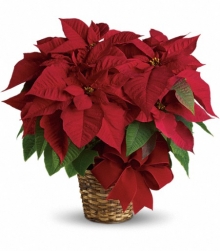Poinsettia Care
Thursday, March 3 | House Plants
The poinsettia, often referred to as the "Christmas Plant", was first brought to the USA from its native land in Mexico, in 1825 by ambbassador Joel Robert Poinsett. Today, with a multitude of colors, sized and shapes available, poinsettias offer an abundance of holiday cheer for every decor.
Tips for the Wise Consumer
Thinking about the following tips while making your poinsettia selection will help you to have a plant that will last throughout the holiday season.
If you buy your poinsettia at a retail store that does not specialize in plants, the store may not provide proper care for the plant. Remember when purchasing your poinsettia to choose the one that is not wilted and appears to be cared for. Avoid the plants with foliage that is beginning to yellow.
The actual flowers of the poinsettia plant are the golden yellow clusters (cyathia) in the center of the colored bracts (the colored bracts are actually the plant's leaves that changed color to attract insects and not flower petals as most consumers think). As you choose your poinsettia, make sure the plant you choose still has the cyathia.
If you purchase your poinsettia from a store that has kept the plastic or paper sleeve packaging on the plant, remember, if this packaging has been kept on the poinsettia for a lengthy amount of time, the leaves may turn yellow and drop before the holiday season is over.
Temperature Control
When you walk out of the store with your poinsettia, remember that the plant needs protection from the weather, especially if the temperature is freezing. If the store did not provide a plant sleeve for your plant, ask them for one - even a grocery bag would be helpful. Your poinsettia should not be exposed (even in the wrapping) to the freezing conditions for more than a short trip to the car. Do not leave your poinsettia in your car while you finish shopping. If the poinsettia is chilled below 50° F, it may begin to drop leaves. Immediately unwrap your poinsettia when you arrive at your destination.
At Home
Locate your plant in a spot with bright natural light, but not exposed to direct sunlight for more than one to two hours. If in a sunny location, make sure the plant never dries out. Do not place your plant in an area that is exposed to drafts, heat from appliances, radiators, or ventilation ducts. Your poinsettia should be placed in an area not exposed to heavy traffic. And, though not poisonous, the plant should be placed away from small children and animals. Ingestion of the plant could cause discomfort.
If the poinsettia you bring home has a pot cover of foil wrapper, pierce the bottom to allow for proper drainage. Remember to place your plant on a waterproof container to catch the overflow when you water.
The soil should be kept moise. Do not let the soil dry out. Empty any water that drains into the container under your plant; if you let the plant sit in this water, the leaves will yellow and drop.
The color of your poinsettia will last longer with temperatures not over 75° F during the day and 60°-65° F at night.
Re-flowering You Poinsettia
If you are an enthusiastic gardener, you may want to try to reflower your poinsettia for next year's holiday season. Just remember, if you seem to lose interest in this along the way, you are in the company of many others! This process requires a lot of dedication and effort.
Fist Step - Care: This holiday season - remember to take care of your plant (refer to the preceding care tips). Do not let your plant dry out!
February - Light: Your poinsettia may begin to fade in color. Keep your plant near a sunny window.
April - Trimming: During the middle of April, cut the stems back to approximately 6" above the soil.
May - Fertilizing: Start fertilizing with a balanced (20-20-20 or 20-10-20) fertilizer at a one teaspoon per gallon of water every third watering.
June - Repotting time?: Remove the plant, and check to see if the plant needs repotting (an abundance of roots). If you do repot, use high quality potting soil and a little larger pot. The pot may be placed outside in a light shade when the temperature does not fall below 55° F or, you can leave the plant inside. Fertilize with one teaspoon of a balanced fertilizer per gallon ofwater every second time you water.
Middle of August - Inside Care: The plant should be kept inside in direct sunlight. Cut the stems back again, this time leaving three or four leaves per stem. Continue to water and fertilize.
Middle of September to the First of December: The plant should stay in direct sunlight (next to a window) until 5:00pm. From 5:00pm to 8:00am the plant should be placed in complete darkness. You may be wondering, "how do I accomplish this?" Some options are putting the plant in a closet or putting the plant in a light-tight box.
Now, you have your poinsettia to enjoy again for the new holiday season, but wait, you may be wondering, "why doesn't it look like the plants in the stores?". Remember that even though you have provided all the care your plant needs by following the directions outlined above - you cannot provide a professional greehouse environment. The professional greenhouse offers an environment with controlled lighting, controlled temperatures, and professional growers. This environment will most likely produce a larger, fuller plant than you could produce in your home.
If you should decide to repeat the re-flowering process, your plant will be about 2 to 4 inches taller each year and should accordingly be cut back about 2 to 4 inches higher every year and definitely repotted into a bigger pot.





